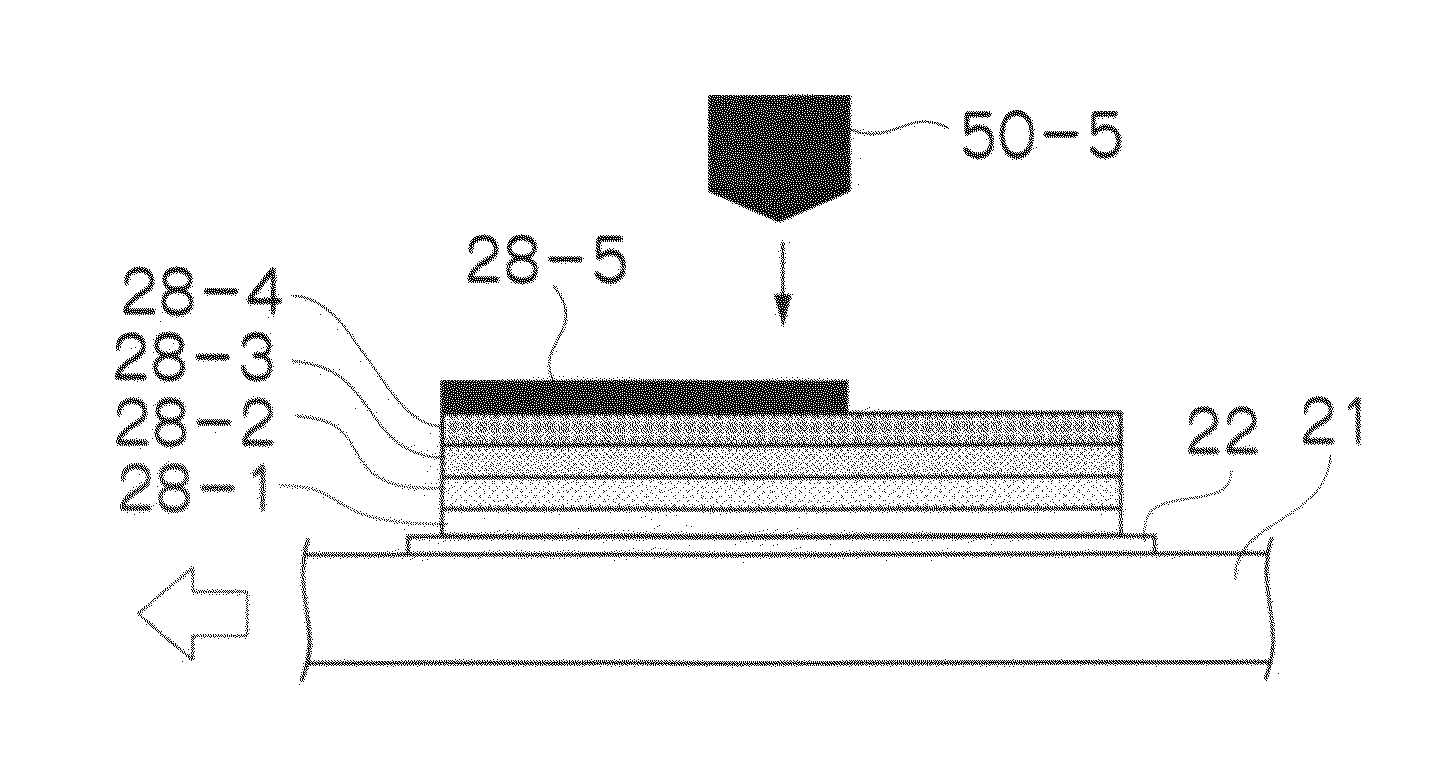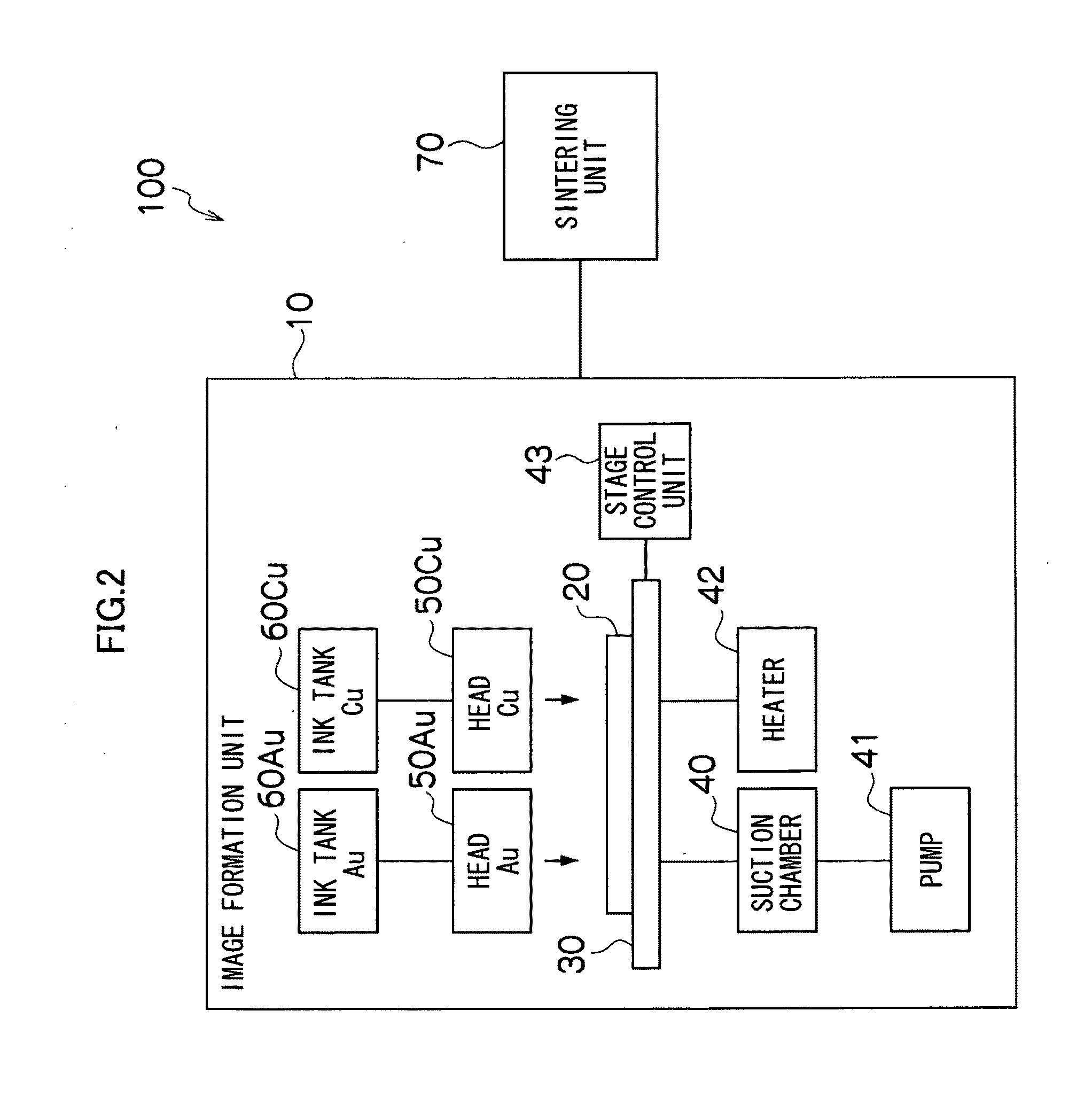Method and apparatus of manufacturing functionally gradient material
a technology of functional gradients and gradients, applied in the direction of coatings, chemistry apparatus and processes, printed circuit aspects, etc., can solve the problems of failing to teach functional materials in which properties, or the like, gradually change continuously or in a stepwise fashion
- Summary
- Abstract
- Description
- Claims
- Application Information
AI Technical Summary
Benefits of technology
Problems solved by technology
Method used
Image
Examples
first embodiment
Configuration of Bump Forming Apparatus
[0042]FIG. 2 is a general schematic diagram of a bump forming apparatus 100 relating to a first embodiment, and FIG. 3 is a schematic drawing of an image formation unit 10 of the bump forming apparatus 100. As shown in FIGS. 2 and 3, the bump forming apparatus 100 has an image formation unit 10 and a sintering unit 70, and the image formation unit 10 employs a flat head type inkjet image forming apparatus. More specifically, the image formation unit 10 includes a stage 30 on which an IC wafer 20 forming a base material is loaded, a suction chamber 40 for holding the IC wafer 20 loaded on the stage 30, by suction, and inkjet head 50Au and inkjet head 50Cu which eject respective inks onto the IC wafer 20.
[0043]The IC wafer 20 is a plate-shaped member that is made of silicon and has a substantially circular planar shape, and a plurality of IC chips 21 (not illustrated in FIG. 2 and FIG. 3) are formed on the surface of the IC wafer 20.
[0044]The sta...
second embodiment
[0098]Next, a second embodiment of the present invention will be described. The description given below does not explain the composition which is the same as or similar to that of the first embodiment described above. In the first embodiment, each layer of a bump which is a functionally gradient material are formed by an image formation mixing method which ejects a plurality of pure inks and diffuses and mixes the inks together by image formation, but in the second embodiment, each layer is formed by ejecting mixed inks which are diffused and mixed in advance.
Composition of Bump Forming Apparatus
[0099]FIG. 7 is a general schematic drawing of a bump forming apparatus 101 relating to a second embodiment. As shown in FIG. 7, the bump forming apparatus 101 relating to the present embodiment includes an image formation unit 11, and the image formation unit 11 includes ink tanks 60-1 to 60-5 which store inks of five types, and inkjet heads 50-1 to 50-5 to which inks are supplied from the ...
modification examples
Other Modification Examples
[0227]FIGS. 20A and 20B are illustrative diagrams of a mode where, when generating a functionally gradient material using components of two types, the component having a smaller volume ratio (Au nano-particle ink) is applied first and the component having a larger volume ratio is applied subsequently.
[0228]The dots 24-2-Au-1 indicated by the diagonal hatching in FIG. 20A are dots formed by Au nano-particle ink which is applied first. On the other hand, the dots 24-2-Cu-1 indicated by the broken line are virtual dots formed by Cu nano-particle ink that is to be applied after applying the Au nano-particle ink.
[0229]The volume ratio of the Au nano-particle ink to Cu nano-particle ink is 2:8, and the numerical quantity ratio between the dots 24-2-Au-1 formed by Au nano-particle ink and the dots 24-2-Cu-1 formed by Cu nano-particle ink is specified by this ratio.
[0230]Although not illustrated, dots 24-2-Cu-1 made by Cu nano-particle ink are formed at the same d...
PUM
| Property | Measurement | Unit |
|---|---|---|
| thickness | aaaaa | aaaaa |
| temperature | aaaaa | aaaaa |
| temperature | aaaaa | aaaaa |
Abstract
Description
Claims
Application Information
 Login to View More
Login to View More - R&D
- Intellectual Property
- Life Sciences
- Materials
- Tech Scout
- Unparalleled Data Quality
- Higher Quality Content
- 60% Fewer Hallucinations
Browse by: Latest US Patents, China's latest patents, Technical Efficacy Thesaurus, Application Domain, Technology Topic, Popular Technical Reports.
© 2025 PatSnap. All rights reserved.Legal|Privacy policy|Modern Slavery Act Transparency Statement|Sitemap|About US| Contact US: help@patsnap.com



